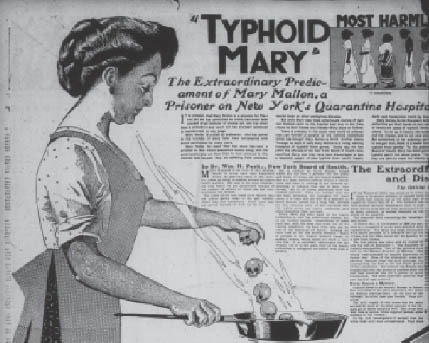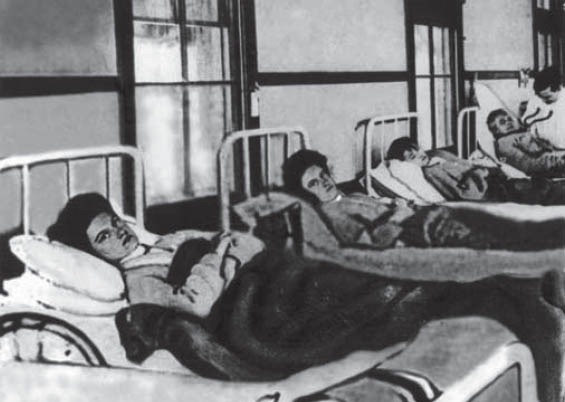Abstract
Mary Mallon was born in 1869 in Ireland and emigrated to the US in 1884. She had worked in a variety of domestic positions for wealthy families prior to settling into her career as a cook. As a healthy carrier of Salmonella typhi her nickname of “Typhoid Mary” had become synonymous with the spread of disease, as many were infected due to her denial of being ill. She was forced into quarantine on two separate occasions on North Brother Island for a total of 26 years and died alone without friends, having evidently found consolation in her religion to which she gave her faith and loyalty.
Keywords: Typhoid fever, salmonella, Mary Mallon, carrier, New York
Isolating Salmonella
Long before the bacillus responsible for the disease was discovered in 1880, Karl Liebermeister had already assumed that the condition was due to a microorganism. He also tried, with his colleagues, to demonstrate that the spread of epidemic was related to drinking water contaminated by the excrement of patients with typhoid fever [1]. William Budd, a doctor in Bristol who was interested in cholera and in intestinal fevers, demonstrated in 1873, that typhoid fever could be transmitted by a specific toxin present in excrement and that the contamination of water by the feces of patients was responsible for that propagation. According to Budd, every case was related to another anterior case. A great number of doctors and scientists had tried to discover the nature of the microorganism responsible for the disease and had encountered great difficulty in isolating the bacillus. It was Karl Joseph Eberth, doctor and student of Rudolf Virchow, who in 1879 discovered the bacillus in the abdominal lymph nodes and the spleen. He had published his observations in 1880 and 1881. His discovery was then verified and confirmed by German and English bacteriologists, including Robert Koch [2]. The genus “Salmonella” was named after Daniel Elmer Salmon, an American veterinary pathologist, who was the administrator of the USDA research program, and thus the organism was named after him, despite the fact that a variety of scientists had contributed to the quest [3]. Salmonella thus became new scientific knowledge and therefore the contagion mechanisms, as well as the existence of healthy carriers were relatively in status nascendi [4].
The contagion
Mary Mallon was born in Ireland in 1869 and emigrated to the United States in 1883 or 1884. She was engaged in 1906 as a cook by Charles Henry Warren, a wealthy New York banker, who rented a residence to Oyster Bay on the north coast of Long Island for the summer. From 27 August to 3 September, 6 of the 11 people present in the house were suffering from typhoid fever. At this time, typhoid fever was still fatal in 10% of cases and mainly affected deprived people from large cities [5,6].
The sanitary engineer, committed by the Warren family, George Sober, published the results of his investigation on the 15th of June 1907, in JAMA. Having believed initially that freshwater clams could be involved in these infections, he had hastily conducted his interrogation of the sick people and also of Mary who had presented a moderate form of typhoid [7]. Mary continued to host the bacteria, contaminating everything around her, a real threat for the surrounding environment. Although Sober initially feared that the soft clams were the culprits, this proved to be incorrect as not all of those stricken had eaten them. Finally Sober had solved the mystery and became the first author to describe a “healthy carrier” of Salmonella typhi in the United States. From March 1907, Sober started stalking Mary Mallon in Manhattan and he revealed that she was transmitting disease and death by her activity. His attempts to obtain samples of Mary’s feces, urine and blood, earned him nothing but being chased by her. Sober reconstituted the puzzle by discovering that previously the cook had served in 8 families. Seven of them had experienced cases of typhoid. Twenty-two people presented signs of infection and some died [5,6].
That year, about 3,000 New Yorkers had been infected by Salmonella typhi, and probably Mary was the main reason for the outbreak. Immunization against Salmonella typhi was not developed until 1911, and antibiotic treatment was not available until 1948 [4]. Thus, a dangerous source like Mary had to be restrained. Mary was then frequently accused of being the source of contact for hundreds of the ill. Sober, after enlisting the support of Dr. Biggs of the N.Y. Department of Health, persuaded Dr. Josephine Baker, who along with the police, was sent to bring Mary Mallon in for testing. Baker and the police were met by an uncooperative Mary, who eluded them for five hours. At the end she was forced to give samples. Mary’s stool was positive for Salmonella typhi and thus she was transferred to North Brother Island to Riverside Hospital, where she was quarantined in a cottage [5].
In 1909, Mary unsuccessfully sued the health department. During her two-year period of confinement, she had 120/163 stool samples test positive. No one ever attempted to explain to Mary the significance of being a “carrier”, instead they had offered to remove her gallbladder, something she had denied. She was unsuccessfully treated with Hexamethylenamin, laxatives, Urotropin, and brewer’s yeast. In 1910, a new health commissioner vowed to free Mary and assist her with finding suitable employment as a domestic but not as a cook. Mary was released but never intended to abide by the agreement. She started working again in the cuisines of her unsuspecting employers, threatening public health once more [4].
As a cook of Sloane Maternity in Manhattan, she contaminated, in three months, at least 25 people, doctors, nurses and staff. Two of them died. She had managed to be hired as “Mary Brown” [8]. Since then she was stigmatized as “Typhoid Mary” (Fig. 1) and she was the butt of jokes, cartoons, and eventually “Typhoid Mary” appeared in medical dictionaries, as a disease carrier. Mary was placed back on North Brother Island where she remained until her death. On Christmas morning, 1932, a man who came to deliver something to her found Mary on the floor of her bungalow, paralyzed. She had had a stroke of apoplexy and never walked again. Thereafter, for six years, she was taken care of in the “Riverside Hospital” (Fig. 2). She died in November 1938. Her body was hurried away and buried in a grave bought for the purpose at St. Raymond’s Cemetery in Bronx. A post mortem revealed that she shed Salmonella typhi bacteria from her gallstones raising the issue of what would have happened if she had accepted the proposed operation. Some other researchers insisted that there was no autopsy and that this was another urban legend, whispered by the Health Center of Oyster Bay, in order to calm ethical reactions [5].
Figure 1.

Mary Mallon as “Typhoid Mary” in the local newspaper of the era
Figure 2.

Mary Mallon in the “Riverside Hospital”
Mary Mallon, the first known case of a healthy carrier in the United States, was proven responsible for the contamination of at least one hundred and twenty two people, including five dead [5].
Ethical issues
Much speculation remains regarding the treatment that Mary received at the hands of the Department of Health, City of New York. She was never fined, let alone confined. Instead of working with her, to make her realize she was a risk factor, the state quarantined her twice, making her a laboratory pet. Mary endured test after test and was only thinking of how she could cook again. She had become a victim of the health laws, of the press and above all of the cynical physicians, who had plenty of time to test but never had time to talk with the patient [9,10].
Mary’s case is a perfect example of how the Health Care system provokes social attitudes towards disease carriers, often associated with prejudice. This case highlighted the problematic nature of the subject and the need for an enhanced medical and legal-social treatment model aimed at improving the status of disease carriers and limiting their impact on society [9,10]. Probably the answer to the rhetorical question “was Mary Mallon a symbol of the threat to individual liberty or a necessary sacrifice to public health?” is a single word, “balance”. After all what Mary ever wanted was to be a good plain cook [11].
Concluding remarks
The history of Mary Mallon, declared “unclean” like a leper, may give us some moral lessons on how to protect the ill and how we can be protected from illness. Mary had refused the one operation which might have cured her. In later years she lost much of her bitterness and lived a fairly contented if necessarily restricted life. She evidently found consolation in her religion and she was then at perfect peace in the bosom of the church to which she gave the last years her faith and loyalty. By the time she died New York health officials had identified more than 400 other healthy carriers of Salmonella typhi, but no one else was forcibly confined or victimized as an “unwanted ill”. Mary Mallon is always a reference when mentioning the compliance of the laws concerning public health issues. The state’s pursuance and Mary’s stubbornness gave her an awkward place in the history of Medicine.
Biography
Medical School, University of Athens, Athens, Greece
Footnotes
Conflict of Interest: None
References
- 1.Liebermeister KV. Vienna: Alfred Hölder; 1896. Cholera Asiatica und Cholera Nostras; p. 132. [Google Scholar]
- 2.Moorhead R. William Budd and typhoid fever. J R Soc Med. 2002;95:561–564. doi: 10.1258/jrsm.95.11.561. [DOI] [PMC free article] [PubMed] [Google Scholar]
- 3.Oldenkamp EP. Predecessors: veterinarians from earlier times, Daniel Elmer Salmon (1850-1914) Tijdschr Diergeneeskd. 2004;129:554–555. [PubMed] [Google Scholar]
- 4.Fanning WL. Typhim Vitrade mark Vaccine. J Travel Med. 1997;4:32–37. doi: 10.1111/j.1708-8305.1997.tb00770.x. [DOI] [PubMed] [Google Scholar]
- 5.Soper GA. The curious career of Typhoid Mary. Bull N Y Acad Med. 1939;15:698–712. [PMC free article] [PubMed] [Google Scholar]
- 6.Brooks J. The sad and tragic life of Typhoid Mary. CMAJ. 1996;154:915–916. [PMC free article] [PubMed] [Google Scholar]
- 7.Marr JS. Typhoid Mary. Lancet. 1999;353:1714. doi: 10.1016/S0140-6736(05)77031-8. [DOI] [PubMed] [Google Scholar]
- 8.Walton MK, Connolly CA. A look back: nursing care of typhoid fever: the pivotal role of nurses at the Children's Hospital of Philadelphia between 1895 and 1910: how the past informs the present. Am J Nurs. 2005;105:74–78. doi: 10.1097/00000446-200504000-00031. [DOI] [PubMed] [Google Scholar]
- 9.Aronson SM. The civil rights of Mary Mallon. R I Med. 1995;78:311–312. [PubMed] [Google Scholar]
- 10.Rimar Y, Shaoul R. Mary Mallon, Mr. N and Mr. Koch as well. Harefuah. 2005;144:216–218. 229. [PubMed] [Google Scholar]
- 11.Finkbeiner AK. Quite contrary: was «Typhoid Mary» Mallon a symbol of the threats to individual liberty or a necessary sacrifice to public health? Sciences (New York) 1996;36:38–43. doi: 10.1002/j.2326-1951.1996.tb03271.x. [DOI] [PubMed] [Google Scholar]


